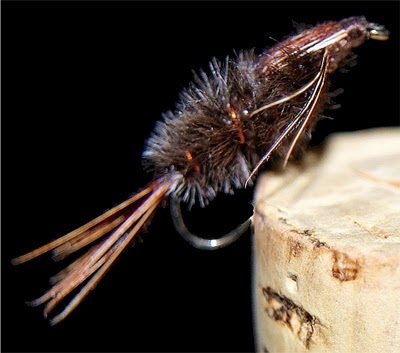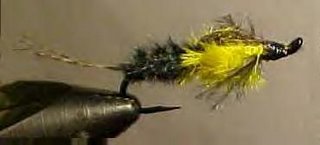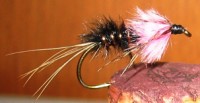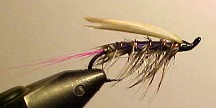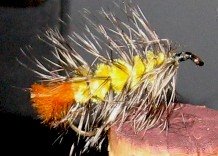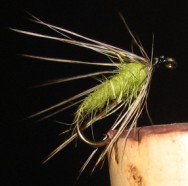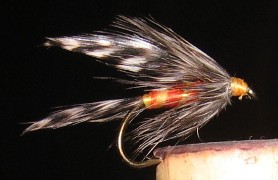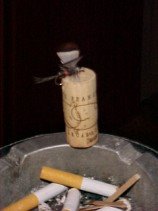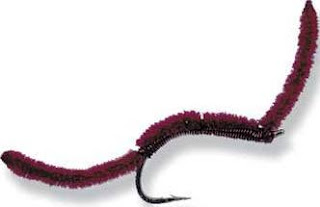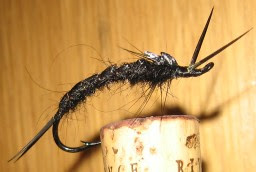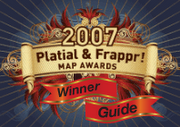.. As August and the terrestrial season approaches we're going to give it one last go with the less clumpy flies.
Flies that even look like flies.
.. We've poked a few local favorites into a mini-box and we're headed to the
to exercise the more tastefully constructed flies available to us.
.. The big, ugly, atrocious, effective creations of foam, plastic, and other synthetic extravagances will have to wait until next weekend, (or beyond.)
.. For now we're using some stuff that would be recognizable as flies to even the most effete among us.
.. These are neighborhood flies and most are variations on classic or well known patterns.
-------
.. We've never been sharp enough to pick the "correct" pattern for the hatch. We've never been skilled enough to to deliver a perfect cast to the perfect spot for the perfect drift with that correct pattern. And our eyes just can't see a fly that's less than a quarter inch long in a thick foam line moving at over 10 mph.

.. So, flailing away, we use a
Zelon Royal Coachman. Usually it's a size 8 - 14. It bobs merrily along it's way flying a white wing and floating as high as a cork, (well, nearly!)
.. It takes fish when the pros are spending precious minutes trying to get their tippet through the eye of very dinky hooks.
.. The only non-Zelon parts are the peacock herl, gold Mylar rib, and furnace, (or badger hackle.) The damn thing is nearly indestructible. We like it very much.
.. Underneath the water's surface, right now, it's hard to beat a woven Antron and hare's ear rubber legs fly
.. We've seen a dozen names for this fly, (tied a dozen different ways.) The neighbors introduced it to us as the
Woven Sally.

.. It works as a
Yellow Sally Nymph. Or Stonefly nymph, or any other sort of big wiggly nymph in streams with heavily-cobbled beds. The sizes we use are 8 - 12.
.. Should you not care to fiddle with a simple woven body there is another nymph that will serve just as well. The
Yellowstone Sally is always in reach and available to us.
.

. It ties quickly and seems to attract quite a lot of trout. It works well on the lakes as well. Sizes we find most useful are 6-8, & 14.

.. For 40 years, or so, we've carried a
Sierra Bright Dot.
.. The classic pattern is reminiscent of an anorexic Royal Coachman. The original pattern is less visible to us now than the chartreuse variant.
.. Sizes from 4 to 18 are in our box but we usually gravitate toward sizes 12 - 16.
.. This little darling, on a long, fine tippet, with a 10' rod can be used for dapping along the edge of the stream where the dark and deep undercut banks hold shy but hungry fish.
.. The generous amount of hackle allows the wind to skitter the fly delicately into position. Many of the largest fish on the
Gallatin River are introverts and need a dancing morsel to entice them to the surface. This one does the trick very nicely.
-------

.. When we suffer the slings and arrows from the neighbors for being just too idiosyncratic in our fly selection we tie on a Fuzzy Adams that was introduced to us as the
Silver Adams.
.. It's nothing special to look at, but the Zelon body twinkles nicely and gets the hecklers off of our back for a short period of time. It catches fish too.
.. Tied in traditional sizes this fly has always seemed to mimic the current hatch, (even caddis.) By using appropriate sizes for the bug on the water this fly can masquerade as any of several different mayflies as well as mosquitoes.
.. If the neighbors refuse to allow us to stick with the Silver Adams when

the mosquitoes are sucking the life from us all, we then use the
Quill Bodied Mosquito or a
Quill Bodied Adams.
.. This version can be used as a searching fly in the larger sizes and when a hatch can be identified on the
Gallatin River the right size will suffice to poke a few trout in the nose.
.. We often start our prospecting with one of these in a size 10. During mid day on the
Gallatin River the body contrasts nicely with the slightly greenish cast of the river.
.. It's a fly we can see. It's a fly that is often refused in a spectacular fashion. We like that.
-------
.. As the days heat up and sun gets lower in the sky we find ourselves fishing the shadows of morning

and evening with the
Simple Silver.
.. This heavy streamer casts like a lead turd but swims nicely on long swings through the sinuous bends of the
Gallatin River.
.. Given the right shadows, deep undercut banks, and a 7 foot leader this fly will wake up both the fish and fisher.
.. The heavy hook, tinsel and twist body, and sparse dressing allow the fly to get down quickly. The silver hackle wing, red throat, and peacock topping catch whatever color light is available. The wood duck tail is a perfect target for trout in dim light, (so we've been told.)
.

. Our concession to the currently proliferating population of land dwellers is a
CDC Ant and, perhaps surprising to some, a large
Griffith's Gnat.
.. The CDC Ant is a straightforward pattern with CDC substituted for the traditional wing. We use sizes in the 10 - 14 range and apply no flotant. We fish the ant near the bank and dry it often. Ants are prolific right now and we certainly ain't going to pass up the opportunity to use them.
.. The
Griffith's Gnat, (tied very tightly with dark hackle,) can be greased and massaged to the point that it makes a more

than passable beetle, (or something,) imitation.
.. It's a fine small dry in sizes 16 - 20, and an excellent "terrestrial" in sizes 6 - 12.
.. Of course we have 'real' beetles: green ones, black ones, hair ones, foam ones, cork ones, and most of the others.
.. Over the last few years we've taken a liking to forming these little gnats into the beetles that our imagination tells us that the fish will take. Sometimes we're right.
.. The hoppers are visible. They are beginning to get their wings. Soon we will all be driven to "HOPPER MADNESS." It will become a genuine madhouse if the predicted blight arrives in
Yellowstone National Park.
.. But for the next few days we will exercise flies that look like flies, (mostly.) We will usher in the terrestrial season with one last flurry of floaters and sinkers that seem to be copacetic. We will succumb to the pressure of the neighbors and "fish the way we ought to." But not for too much longer.
-------



























